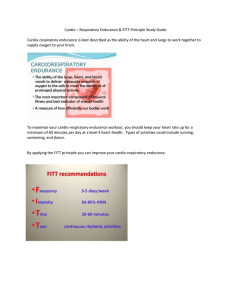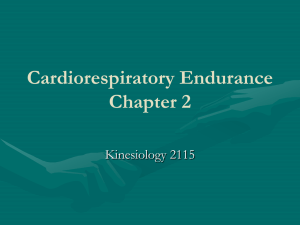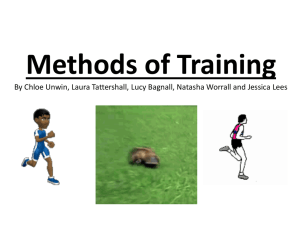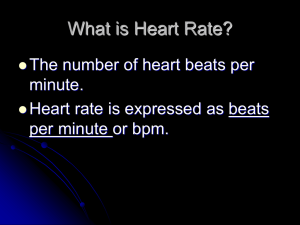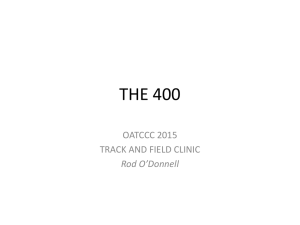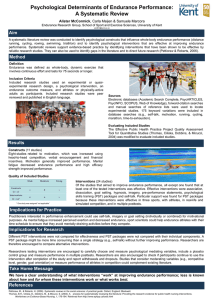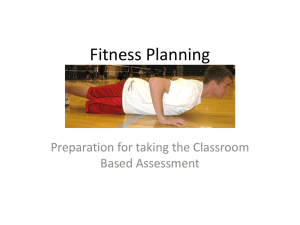Cardio-Respiratory Endurance (CRE)
advertisement
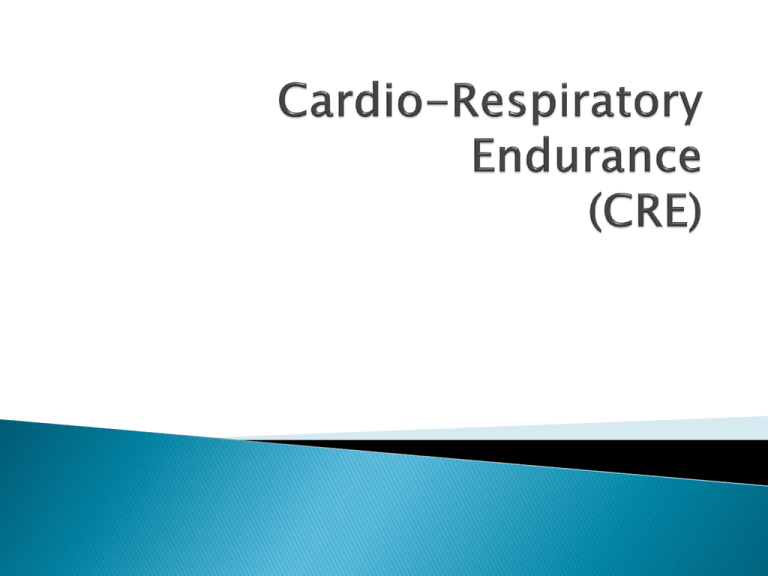
Is the ability of the heart and lungs to get oxygen to the muscles, so that the muscles can perform for a long time Give specific examples of 2 aerobic activities Effective cardio-respiratory endurance is the ability to sport sufficient oxygen to the working muscles during sustained exercise. In activities that last relatively long periods of time, improved cardio-respiratory endurance provides you with the chance to perform better by being able keep skill level high. 12mins 20m Cooper Test Progressive Shuttle Run Test Harvard Step Test Your maximum heart rate (MHR) is the highest number of beats per minute your heart can reach during all-out effort. Because maximum heart rate decreases as you get older, a popular calculation used is: 220 - age = MHR For example, a 15-year-old male would have an MHR of 220 - 15 = 205 beats per minute. Follow the steps above to calculate your MHR. Once you have calculated your MHR, it is then possible to calculate your heart rate training zones, which are as follows: Zone % MHR Description 1 60 - 65 Easy running, recovery training 2 65 - 70 Endurance base training 3 70 - 75 Aerobic capacity training 4 80 - 85 Lactate threshold training Take your MHR and multiply by 0.60 and 0.75 to determine your aerobic training zone. If your MHR is 205, you would multiply that number by 0.60 and 0.85 to determine what your aerobic training zone (which would be 123 to 174 beats per minute). Once you know your starting level of CRE (above average, average or below average) you can consider what type of training exercises are best. It is important to realise that your training becomes more demanding as time goes on. Any exercises (e.g.. running, swimming, cycling) that ensures that the heart rate is operating in your training zone for approximately 20 to 30 minutes for 3 to 4 sessions per week. Benefits 1. 2. 3. 4. Develops cardio-respiratory endurance Develops aerobic capacity Straight forward to plan Progressive overload achieved by exercising more often, by exercising faster, or by training longer. (Frequency, Intensity, Duration) Interval running enables the athlete to improve the workload by interspersing heavy bouts of fast running with recovery periods of slower jogging. The athlete runs hard over any distance up to 1k and then has a period of easy jogging. During the run, lactic acid is produced and a state of oxygen debt is reached. During the interval (recovery), the heart and lungs are still stimulated as they try to pay back the debt by supplying oxygen to help break down the lactates. Continuous running or swimming with short sprint bursts followed by a slower recovery and then more continuous paced running or swimming. Benefits 1. 2. 3. Develops both aerobic and anaerobic fitness through continuous running and short speed endurance sprints Can be varied to suit your own requirements. Progressive overload achieved by exercising more often, by exercising faster, or by exercising longer. F.I.D. (F)REQUENCY – How often you train each week • Increase the amount of times in a week you train e.g.. from 3 to 4. You can monitor your progress when exercising by checking your pulse regularly to see if it is in your aerobic training zone. The easiest way to check your pulse is to check your heart rate during exercise for 6 seconds then multiply this number by 10 to get your heart rate per minute. 1. 2. 3. Regular exercise is very good for the heart and lungs: it increases the strength of the heart. The lower your heart rate the fitter you are and it will take longer to reach maximum heart rate. After exercise the fitter you are the faster your pulse will return to normal. (i) What is meant by cardio-respiratory endurance? 2 marks (ii) Name a test you could use to measure cardio-respiratory endurance. 1 mark (iii) Short term effects take place in the body during a cardio-respiratory exercise session. Name three short term effects. 3 marks (i) Two methods of training used to develop cardio-respiratory endurance are interval training and varied pace training/fartlek. Choose one of these methods of training. Describe in detail what you did in one training session to develop your cardiorespiratory endurance. 2 marks (ii) In many activities you need high levels of cardio-respiratory endurance. Choose an activity. Describe one benefit that high levels of cardio-respiratory endurance may have on your performance in this activity. 2 marks
